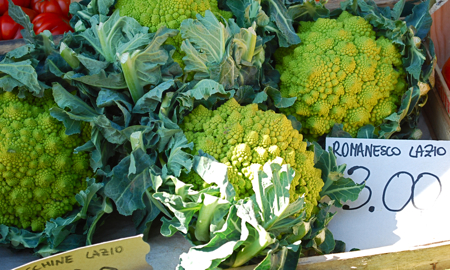By early evening, the Campo de’ Fiori teems with rowdy Roman teenagers, chain-smoking twenty-somethings, and packs of study-abroad students reveling in euro-fifty quartini of table wine. But after the stragglers wander home in the early morning light, the piazza reverts to its natural state: a vibrant, bustling food market.
Just south of the Piazza Navona, the Campo de’ Fiori has unshakeable tourist appeal, and locals may choose to shop elsewhere. But with dozens of vendors hawking the season’s freshest produce, the market is an undeniable sensory feast.
What first struck me about Italian markets, in Rome and in Bologna, is how one can buy any ingredient, in any amount—no matter how large, small, or specific. Walk up to a display of piselli, and you can purchase a kilo of fresh peapods—or a kilo of shelled, loose peas. Cauliflower is sold by the head, or by the floret. And even lettuces are sold loose, with vendors bagging only what the customer needs for a given night. In the same way that Romans buy their breads and baked goods by weight, in whatever size slice they wish, produce comes in whatever form the customers asks (or, often, negotiates).

And as the sun grows warmer and winter fades to spring, each week brings newly seasonal products that appear and take over the market within days. In early spring, the broccoli-like Romanesco appears, its curious, fractal shape unlike any other vegetable; around the same time arrive the carciofi, artichokes that appear on every Roman menu overnight. Also heralding spring are the chive-shaped, spinach-like agretti, matchstick-thin asparagina, and, later in the season, orange zucchini blossoms just waiting for the deep-fryer.
Bright displays, hopeful merchants, wide-eyed customers: in some respects, markets look the same the world over. But to the careful eye, there's something new to be found in every market, with every visit.